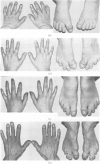Abstract
A family with Pfeiffer's syndrome is presented in which members of two generations showed only partial but relevant syndactyly before a child was born, in the third generation, with the full acrocephalosyndactyly syndrome.
Full text
PDF






Images in this article
Selected References
These references are in PubMed. This may not be the complete list of references from this article.
- Escobar V., Bixler D. The acrocephalosyndactyly syndromes: a metacarpophalangeal pattern profile analysis. Clin Genet. 1977 Apr;11(4):295–235. doi: 10.1111/j.1399-0004.1977.tb01316.x. [DOI] [PubMed] [Google Scholar]
- Jackson C. E., Weiss L., Reynolds W. A., Forman T. F., Peterson J. A. Craniosynostosis, midfacial hypoplasia and foot abnormalities: an autosomal dominant phenotype in a large Amish kindred. J Pediatr. 1976 Jun;88(6):963–968. doi: 10.1016/s0022-3476(76)81050-5. [DOI] [PubMed] [Google Scholar]
- Martsolf J. T., Cracco J. B., Carpenter G. G., O'Hara A. E. Pfeiffer syndrome. An unusual type of acrocephalosyndactyly with broad thumbs and great toes. Am J Dis Child. 1971 Mar;121(3):257–262. [PubMed] [Google Scholar]
- Robinow M., Sorauf T. J. Acrocephalopolysyndactyly, type Noack, in a large kindred. Birth Defects Orig Artic Ser. 1975;11(5):99–106. [PubMed] [Google Scholar]
- Saldino R. M., Steinbach H. L., Epstein C. J. Familial acrocephalosyndactyly (Pfeiffer syndrome). Am J Roentgenol Radium Ther Nucl Med. 1972 Nov;116(3):609–622. doi: 10.2214/ajr.116.3.609. [DOI] [PubMed] [Google Scholar]







